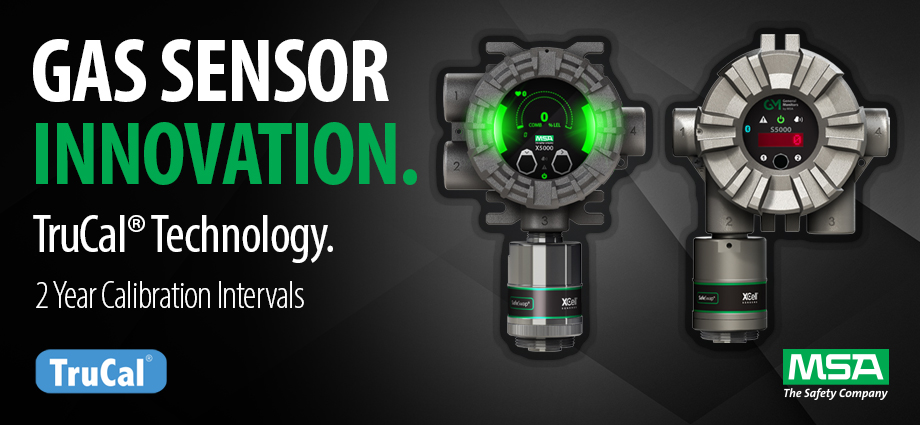
The United States Occupational Safety and Health Administration (OSHA) defines industrial hygiene as “the science of anticipating, recognizing, evaluating, and controlling workplace conditions that may cause workers’ injury or illness.” Simply put, it is the professional study of worker protection. One of the major concerns of industrial hygiene is the identification and control of hazardous atmospheres. Hazardous atmospheres may arise in the workplace from a variety of causes and may contain asphyxiating agents, flammable or combustible gases, irritating, corrosive, or toxic gases and vapors. These environmental hazards are typically invisible to the body’s senses and pose a risk not only to worker safety, life and health, but to the continuous operation of a plant. However, reliable methods of hazardous gas monitoring can help to mitigate these substantial risks. For most gas detectors currently available on the market, the only way to know their readings are accurate is to expose the instrument to a known concentration of test gas. This can be laborious, time consuming (especially for inaccessible sensors), intrusive, and add to maintenance costs.
Fixed gas detectors usually include several different types of sensors. The atmosphere in which the instrument is used can have a profound effect on the sensors. Each type of sensor uses a slightly different detection principle. Sensors may be poisoned or suffer degraded performance if exposed to certain environmental conditions or substances. The kinds of conditions that affect the accuracy of sensors vary from one type of sensor to the next and electrochemical sensors are especially affected by the environment. Creating electrochemical reactions is relatively easy. However, controlling and maintaining results from these reactions is the challenge. It is well recognized that gas sensors have limited lifetimes and their sensitivities can deteriorate from unintentional exposure to some gases, vibration and shock. Moreover, dust and dirt can also impair gas flow to the sensor. This is a major reason why frequent inspections, functional checks, maintenance and calibrations must be performed by the user.
Electrochemical sensors use an electrochemical reaction to generate a current proportional to the gas concentration. The sensor is a chamber containing a gel or electrolyte and electrodes. The gas sample enters the casing through a membrane; oxidation occurs at the working electrode and reduction takes place at the counter electrode, resulting in ions flow which creates a current. Measurement of this current is converted into a displayed gas reading.While some electrochemical sensors used to measure toxic gases such as carbon monoxide (CO) and hydrogen sulfide (H2S) are not worn out or consumed by exposure to CO or H2S, they still eventually need to be replaced. The electrolyte or one or more of the electrodes will usually limit the life of the sensor. The sensitivity will require periodic recalibration or response checking. Although CO and H2S sensors may last for years without significant loss of sensitivity, the loss of sensitivity may sometimes be sudden and dramatic. Incidental exposure to other substances also may reduce sensitivity. For instance, many electrochemical sensors can be permanently affected by exposure to organic solvents and alcohols. Exposure to methanol is well known to affect the performance of CO and H2S sensors.
Major international standards for performance of combustible and oxygen detectors1 provide general warning, valid also for toxic sensors, about possible adverse effect on sensors due to airborne contaminants such as dusts, wet, oily adhesive sprays and mists. Particularly, they can result in loss of sensitivity or even block the diffusion path for gas to the sensor inlet. Moreover, sometimes things like paint overspray or deliberate painting, can affect gas detector availability. Therefore, clear mitigating recommendations are given for regular inspection by a competent person, including calibration, visual inspection of not only the transmitter but also the gas sensor inlets for blockages.
International gas detection standards (ISA / IEC / EN 60079-29-2 – p. 8.12) provide guidance that not only will periodic calibrations be required but also functional checks which are detailed in manufacturers’ instruction manuals as well as local regulations. There is no single rule for maintenance frequency which can fit to all applications, due to the fact the conditions of use can be different.
The performance of a gas detector is unknown between calibration periods, so defining the calibration intervals for optimal safety becomes a critical challenge. That is why environmental and site conditions should be considered which can result in a large difference in required calibration periods ranging from days to months.
Exposing the instrument to a known concentration test gas verifies both the accuracy of the readings and the proper performance of the instrument’s alarms. Failure to periodically test and document the performance of fixed gas detectors can leave a facility open to regulatory citations or fines, as well as increased liability exposure in the event a worker is injured in an accident.
The International Safety Equipment Association (ISEA) also provides guidelines for the calibration, validation and use of personal, portable gas detection instrumentation.2The ISEA defines three levels of calibration or other validation of performance as: full calibration, calibration check, and bump test.
However, the ISEA does not provide a similar statement of the validation of permanently installed gas monitoring equipment. There are guidelines on selecting and deploying monitors for permanent applications, but calibration frequency and other instrument validation is generally left to the instrument manufacturers’ recommendations, or site-specific requirements.
Typical manufacturer’s recommendations suggest 90 to 180-day calibration intervals, with generally no requirement to perform periodic validation checks.
Clearly, these requirements place a large burden of responsibility on the end user of gas detection instrumentation, the organization installing the instrumentation, and the manufacturer of the instrument. The requirement for regular, periodic calibration, and event-driven calibration necessitates the purchase and general availability of calibration devices, gases, and supplies as well as the burden of record keeping. This burden becomes even more clear, recognizing that many industrial sites require each worker to carry a personal gas detection instrument, the total quantity of which may easily exceed 1,000 units at a given site, along with permanently mounted and area monitoring instrumentation for the same gaseous hazards. Finally, the information gap between portable and permanent gas detection instrumentation is glaring; the requirement for at least daily validation for portable instruments versus 90 to 180-day cycles of full calibration for permanent instruments. Bear in mind that portable and permanent instruments generally utilize the same type of electrochemical sensors.
The pulse check uses MSA’s patented technology to calculate gas response by applying an electronic pulse to the sensor and analyzing the response curve (as shown in Fig. 1). Through proprietary algorithms, MSA can quantify gains and losses in output sensitivity that result in real-time accuracy adjustments during the pulse check. Other than its age, a sensor’s change in sensitivity is typically caused by its environment, including temperature, pressure and humidity.
The pulse check calculates the change in sensor output response electronically. A pulse is applied to the sensor where the response is analyzed and compared to the last manual gas calibration. This is used to monitor for any change in the sensor’s sensitivity and if necessary, adjust it to be in line with the last gas calibration. It also verifies that the internal sensor components are functioning properly. Sensor output sensitivity is comprised of quantifiable aspects of internal sensor components. Sensitivity can be measured without the use of test gas, as is traditionally applied during a manual calibration.
Output from a regression model is used to determine whether the sensor requires its sensitivity adjusting to correspond with the last manual gas calibration or if due to an extreme change in its sensitivity, it will indicate that a manual calibration is required. This automatic adjustment in the sensor’s sensitivity is referred to as Adaptive Environmental Compensation (AEC).
Such adjustment is possible due to MSA‘s application-specific integrated circuit (ASIC) used in MSA’s XCell Sensors. The pulse check occurs four times per day, takes less than 1 second and does not take the instrument off-line or affect the transmitter’s analog output.
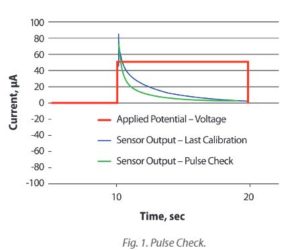
However impressive the sensor’s Pulse Check and AEC features, they are of little value to the end user if the target gas is unable to reach the internal electrochemical cell due to a physical blockage of the sensor’s inlet (as illustrated in Fig. 2). Virtually all gas detection instruments deployed for industrial hygiene applications have protective membranes to protect both the sensor and the internal components of the instrument. Most, if not all, such instruments are designed in such a way that they protect the sensor and the instrument itself from particles, dusts, sprays and liquid intrusion. Instruments used in hazardous areas also often have a flame arrestor or sinter/frit to prevent the internal electronics from causing an explosion. Proper functionality of the instrument requires that the gas passes efficiently and effectively through such protective barriers. Figures of merit such as the sensor’s response time, precision, and accuracy to the target gas are irrelevant if the inlet to the sensor is blocked and the gas cannot reach the electrochemical cell.
Unfortunately, during normal operation and use, instrument diffusion membranes or sinters/frits can become partially or fully blocked from a variety of causes. These include mud, sand, dust and dirt, paint or glue, overspray or vapor, water and/or ice, insect or animal deposits, or any other extraneous diffusion-impeding substances or events. Blockage of the diffusion path into the instrument and sensor may be partial or complete. “Blockage” may be simply that, physical disruption of the flow path, or it may be due to the presence of reactive or absorptive materials deposited on membranes or frits. A common example of this might be liquid water or excess moisture which will dissolve common toxic gases such as hydrogen sulfide (H2S), sulfur dioxide (SO2), or chlorine (Cl2). Obviously, blockage of diffusion membranes or other gas entry paths could result in changes to the precision or accuracy of the instrument or it may affect the response time of the instrument.
Periodic bump tests, as previously described, are one established method of providing a relatively high degree of assurance that the gas detector is properly functional, at least at the time and place that the bump check was performed. However, bump testing an instrument is time consuming, labor intensive (depending on the number of sensors and where they are located throughout a facility), and calibration gas can be expensive. Users of fixed H2S and CO gas detectors that take advantage of this new Diffusion Supervision technology, can significantly reduce their cost of ownership, as no maintenance of any kind (unless called for by the detector) is required for up to two years.
Diffusion Supervision employs proprietary acoustic mechanical design and algorithms to measure sound across the sensor’s inlet. If the inlet is blocked, the difference in the sound is detected and the unit is put into fault. When the obstruction is removed, Diffusion Supervision detects the clearance and returns to normal operation.
Diffusion Supervision technology employs a speaker and microphone that are connected by a sound channel that runs across the sensor inlet. When the sensor inlet is not blocked, the sound the speaker emits travels through the flame arrestor and minimal sound is detected by the microphone. If the sensor inlet is blocked, the tone is reflected by the blocked flame arrestor and the microphone detects a stronger signal. The Diffusion Supervision is part of the TruCal test and occurs every 6 hours; the same interval as Adaptive Environmental Compensation.
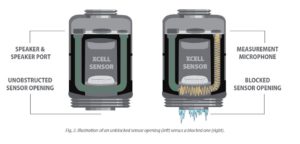
The problem is electrochemical cells rarely fail in a manner that disrupts the circuit. Instead they lose sensitivity to a point where they are no longer able to respond to gas; a condition only discovered during a manual gas calibration. Think of your car battery. One day you get in your car and it will not start. It still holds some voltage and turns the radio on, but that is little consolation when you are trying to get to your destination. Wouldn’t it have been better for your car to tell you two weeks earlier that your battery was about to fail? Competitive sensor checks are similar to knowing that your car’s battery is dead and can no longer start your car. TruCal gives you advance warning to replace your battery before you end up stranded.
TruCal technology has been tested extensively to make sure that it performs under a variety of environmental conditions (see Fig. 3). The accuracy and T90 response times (shown in Fig. 4) have performed flawlessly even without calibration and with constant exposure to the elements. These sensors have been installed on the roof of MSA’s manufacturing facility in Western Pennsylvania and exposed to all climates: hot, cold, rain, snow, sun, wind, humid and dry.
Each of these sensors, sixteen H2S sensors and fourteen CO sensors, were calibrated prior to installation and have been intermittently gas tested to verify response. No calibrations have been conducted on any of these sensors for over three years and Adaptive Environmental Compensation (AEC) has been testing the sensor every six hours and adjusting sensor response to account for changes in its sensitivity due to environmental conditions and sensor degradation.
Even after three years of exposure to the elements and no calibrations, each and every one of these sensors is still performing accurately, even meeting the stringent ISA performance requirements for toxic gas detection. The XCell sensors with TruCal are expected to perform within stated performance specification for two years without manual calibration. For sensors with Diffusion Supervision, there is no requirement for a functional safety check/bump test. This is based on more than 1,200 days of testing of the XCell H2S and CO sensors.

The following two graphs demonstrate the response of non-calibrated H2S and CO sensors within the tested period.
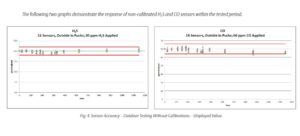
In addition to the accuracy testing, MSA has also measured the T90 response time of each sensor. Even after three years without any calibration or maintenance, the H2S sensors’ T90 times are still less than 35 seconds and the CO sensors’ T90 times are less than 10 seconds (as shown below in Fig. 5).
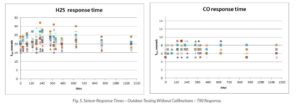
TruCal’s self-checking technology corrects sensor sensitivity to account for any drift and notifies if a manual gas calibration or sensor exchange is required. TruCal reassures the user the detector is functioning correctly and can detect gas by proactively performing a self-check every six hours.
Six actions that TruCal enables:
MSA’s TruCal sets a new standard for reliability while lowering cost of ownership. Since 1914, MSA has been innovating and creating revolutionary gas detection products. Our goal, every day, is to provide workers with dependable, high-quality products, instruments, and service to help ensure a safe return home when the work is done. For more information on TruCal gas sensors, visit MSAsafety.com/trucal.
1 ISA / IEC / EN 60079-29-2 (p. 8.3.3.10) Explosive atmospheres Part 29-2: Gas detectors — Selection, installation, use and maintenance of detectors for flammable gases and oxygen.
2 ISEA Statement of Validation of Operation for Direct Reading Portable Gas Monitors